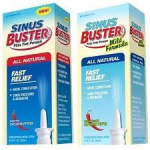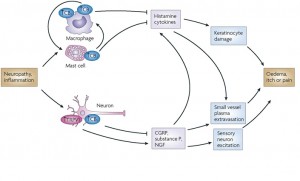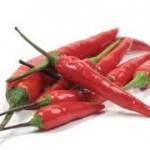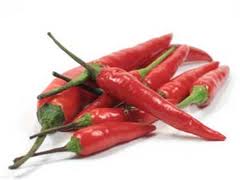Less-than-lethal force
Capsaicin is also the active ingredient in riot control and personal defense pepper spray chemical agents. When the spray comes in contact with skin, especially eyes or mucous membranes, it is very painful, and breathing small particles of it as it disperses can cause breathing difficulty, which serves to discourage assailants.
 In large quantities, capsaicin can cause death. Symptoms of overdose include difficulty breathing, blue skin, and convulsions. The large amount needed to kill an adult human and the low concentration of capsaicin in chilies make the risk of accidental poisoning by chili consumption negligible.
In large quantities, capsaicin can cause death. Symptoms of overdose include difficulty breathing, blue skin, and convulsions. The large amount needed to kill an adult human and the low concentration of capsaicin in chilies make the risk of accidental poisoning by chili consumption negligible.
Pest deterrent
Capsaicin is also used to deter mammalian pests. A common example is the use of ground-up or crushed dried chili pods in birdseed to deter squirrels, since birds are unaffected by capsaicin. Another example is the use of chili peppers by the Elephant Pepper Development Trust to improve crop security for rural communities in Africa.
Although hot chili pepper extract is commonly used as a component of household and garden insect repellent formulas, it is not clear that the capsaicinoid elements of the extract are responsible for its repellency.
There are manufacturers that sell a capsaicin-based gel product that is reported to be a feral-pigeon (Columba livia) deterrent from specific roosting and loafing areas. Some of these products have an EPA label and NSF approval.
Equestrian sports
Capsaicin is a banned substance in equestrian sports because of its hypersensitizing and pain relieving properties. At the show jumping events of the 2008 Summer Olympics, four horses tested positive for the substance, which resulted in disqualification.
Mechanism of action
The burning and painful sensations associated with capsaicin result from its chemical interaction with sensory neurons. Capsaicin, as a member of the vanilloid family, binds to a receptor called the vanilloid receptor subtype 1 (VR1). First cloned in 1997, VR1 is an ion channel-type receptor. VR1, which can also be stimulated with heat and physical abrasion, permits cations to pass through the cell membrane and into the cell when activated. The resulting depolarization of the neuron stimulates it to signal the brain. By binding to the VR1 receptor, the capsaicin molecule produces the same sensation that excessive heat or abrasive damage would cause, explaining why the spiciness of capsaicin is described as a burning sensation.
 The VR1 ion channel has subsequently been shown to be a member of the superfamily of TRP ion channels, and as such is now referred to as TRPV1. There are a number of different TRP ion channels that have been shown to be sensitive to different ranges of temperature and probably are responsible for our range of temperature sensation. Thus, capsaicin does not actually cause a chemical burn, or indeed any direct tissue damage at all, when chili peppers are the source of exposure. The inflammation resulting from exposure to capsaicin is believed to be the result of the body’s reaction to nerve excitement. For example, the mode of action of capsaicin in inducing bronchoconstriction is thought to involve stimulation of C fibres culminating in the release of neuropeptides. Essentially, the body inflames tissues as if it has undergone a burn or abrasion and the resulting inflammation can cause tissue damage in cases of extreme exposure, as is the case for many substances that cause the body to trigger an inflammatory response.
The VR1 ion channel has subsequently been shown to be a member of the superfamily of TRP ion channels, and as such is now referred to as TRPV1. There are a number of different TRP ion channels that have been shown to be sensitive to different ranges of temperature and probably are responsible for our range of temperature sensation. Thus, capsaicin does not actually cause a chemical burn, or indeed any direct tissue damage at all, when chili peppers are the source of exposure. The inflammation resulting from exposure to capsaicin is believed to be the result of the body’s reaction to nerve excitement. For example, the mode of action of capsaicin in inducing bronchoconstriction is thought to involve stimulation of C fibres culminating in the release of neuropeptides. Essentially, the body inflames tissues as if it has undergone a burn or abrasion and the resulting inflammation can cause tissue damage in cases of extreme exposure, as is the case for many substances that cause the body to trigger an inflammatory response.
Toxicity
Acute health effects
Capsaicin is a highly irritant material requiring proper protective goggles, respirators, and proper hazardous material handling procedures. Capsaicin takes effect upon skin contact (irritant, sensitizer), eye contact (irritant), ingestion, and inhalation (lung irritant, lung sensitizer). Severe over-exposure to pure capsaicin can result in death; the lethal dose (LD50 in mice) is 47.2 mg/kg.
Painful exposures to capsaicin-containing peppers are among the most common plant-related exposures presented to poison centers. They cause burning or stinging pain to the skin, and if ingested in large amounts by adults or small amounts by children, can produce nausea, vomiting, abdominal pain and burning diarrhea. Eye exposure produces intense tearing, pain, conjunctivitis and blepharospasm.
Drug interactions
 Capsaicin is indicated as interacting with a number of drugs, including the commonly prescribed high-blood pressure drug Lisinopril, to induce a side-effect cough.
Capsaicin is indicated as interacting with a number of drugs, including the commonly prescribed high-blood pressure drug Lisinopril, to induce a side-effect cough.
Treatment after exposure
The primary treatment is removal from exposure. Contaminated clothing should be removed and placed in airtight bags to prevent secondary exposure.
For external exposure, bathing the mucous membrane surfaces that have contacted capsaicin with oily compounds such as vegetable oil, paraffin oil, petroleum jelly (Vaseline), creams, or polyethylene glycol is the most effective way to attenuate the associated discomfort; since oil and capsaicin are both hydrophobic hydrocarbons the capsaicin which has not already been absorbed into tissues will be picked up into solution and easily removed. Capsaicin can also be washed off the skin using soap, shampoo, or other detergents. Plain water is ineffective at removing capsaicin, as are vinegar, bleach, sodium metabisulfite, topical antacid suspensions, and other home remedies.
Additionally when ingested, cold milk is an effective way to treat the burning sensation (due to caseins having a detergent effect on capsaicin); and room temperature sugar solution (10%) at 20 °C (68 °F) is almost as effective. The burning sensation will slowly fade away over several hours if no actions are taken.
Burning and pain symptoms can also be relieved by cooling, such as from ice, cold water, cold bottles, cold surfaces, or a flow of air from wind or a fan. In severe cases, eye burn might be treated symptomatically with topical ophthalmic anesthetics; mucous membrane burn with lidocaine gel. The gel from the aloe plant has also been shown to be very effective. Capsaicin-induced asthma might be treated with nebulized bronchodilators or oral antihistamines or corticosteroids.
Effects of dietary consumption
Ingestion of spicy food or ground jalapeño peppers does not cause mucosal erosions or other abnormalities. Some mucosal microbleeding has been found after eating red and black peppers, but there was no significant difference between aspirin (used as a control) and peppers. The question of whether chili ingestion increases or decreases risk of stomach cancer is unresolved: a study of Mexican patients found self-reported capsaicin intake levels associated with increased stomach cancer rates (however, this is very likely attributed to Helicobacter pylori) while a study of Italians suggests eating hot peppers regularly was protective against stomach cancer. A preliminary study using county population and mortality data showed significantly higher rates for stomach and liver cancer in counties inhabited by groups with high consumption of capsaicin-rich foods than in matched control counties. Carcinogenic, co-carcinogenic, and anticarcinogenic effects of capsaicin have been reported in animal studies.
